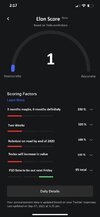It's not opinion. It's based on statistical modeling. If you get a lower score you're more likely to get in an accident. To think otherwise, is denial.
Determining Your Safety Score
In order to calculate your daily Safety Score, we use the
Predicted Collision Frequency (PCF) formula below to predict how many collisions may occur per 1 million miles driven, based on your driving behaviors measured by your Tesla vehicle.
| Predicted Collision Frequency (PCF) = 0.682854 | x | 1.014495Forward Collision Warning per 1,000 Miles |
| x | 1.127294Hard Braking |
| x | 1.019630Aggresive Turning |
| x | 1.001444Unsafe Following Time |
| x | 1.317958Forced Autopilot Disengagement |
The current formula was derived based on statistical modeling using 6 billion miles of fleet data. We expect to make changes to the formula in the future as we gain more customer and data insights.
The PCF is converted into a 0 to 100 Safety Score using the following formula:
| Safety Score = 115.382324 - 22.526504 | x | PCF |
Your daily Safety Score is not impacted by the number of miles or hours you drive. We combine your daily Safety Scores (up to 30 days) into a mileage-weighted average to calculate the aggregated Safety Score, which is displayed on the main ‘Safety Score’ screen of the Tesla app.




